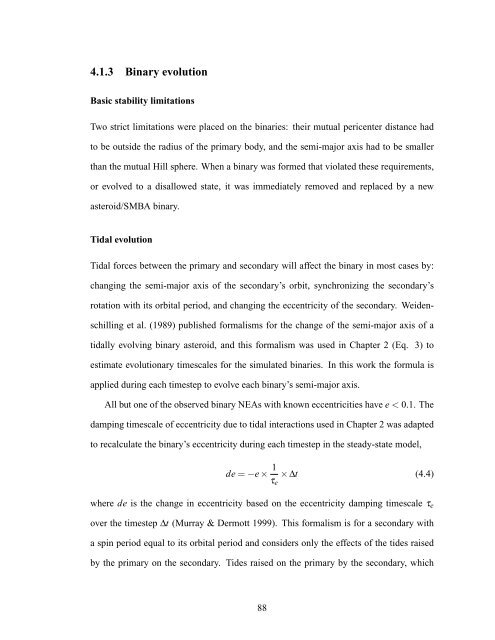Forming Binary Near-Earth Asteroids From Tidal Disruptions
Forming Binary Near-Earth Asteroids From Tidal Disruptions
Forming Binary Near-Earth Asteroids From Tidal Disruptions
Create successful ePaper yourself
Turn your PDF publications into a flip-book with our unique Google optimized e-Paper software.
4.1.3 <strong>Binary</strong> evolutionBasic stability limitationsTwo strict limitations were placed on the binaries: their mutual pericenter distance hadto be outside the radius of the primary body, and the semi-major axis had to be smallerthan the mutual Hill sphere. When a binary was formed that violated these requirements,or evolved to a disallowed state, it was immediately removed and replaced by a newasteroid/SMBA binary.<strong>Tidal</strong> evolution<strong>Tidal</strong> forces between the primary and secondary will affect the binary in most cases by:changing the semi-major axis of the secondary’s orbit, synchronizing the secondary’srotation with its orbital period, and changing the eccentricity of the secondary. Weidenschillinget al. (1989) published formalisms for the change of the semi-major axis of atidally evolving binary asteroid, and this formalism was used in Chapter 2 (Eq. 3) toestimate evolutionary timescales for the simulated binaries. In this work the formula isapplied during each timestep to evolve each binary’s semi-major axis.All but one of the observed binary NEAs with known eccentricities have e < 0.1. Thedamping timescale of eccentricity due to tidal interactions used in Chapter 2 was adaptedto recalculate the binary’s eccentricity during each timestep in the steady-state model,de = −e × 1 τ e× ∆t (4.4)where de is the change in eccentricity based on the eccentricity damping timescale τ eover the timestep ∆t (Murray & Dermott 1999). This formalism is for a secondary witha spin period equal to its orbital period and considers only the effects of the tides raisedby the primary on the secondary. Tides raised on the primary by the secondary, which88












